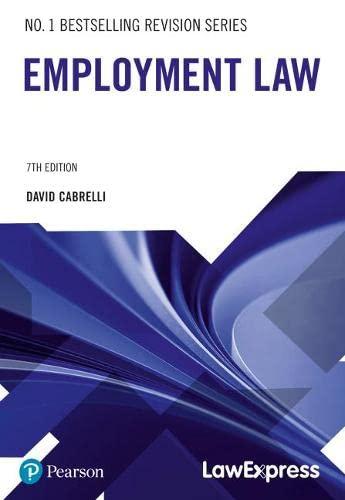Question
What would this look like? please answer the questions at the end. You are the Compliance Officer of the facility where Dr. Shah works and
What would this look like? please answer the questions at the end.
You are the Compliance Officer of the facility where Dr. Shah works and treated the patient, Ms. Robinson. The CEO, Mr. John Doe, asked you to investigate this case, gather relevant facts, and then present recommendations on how best to prevent similar issues from occurring, in the future, with supporting rationale.
Your recommendations should be submitted as a Business Memorandum to the attention of Mr. Doe. Consider the answers to the below questions and statements when conducting your investigation and formulating your recommendations.
Healthcare executives tend to maintain busy schedules; therefore, it's important to present your recommendation in a concise, clear, and logical format.
Caution: Do not use any of the information related to the legal verdict or the lawsuit. You should be looking at this case from an intentional tort angle. Assume that it hasn't gone to trial.
QUESTIONS
1. Provide a brief summary of what happened.
2. Discuss our responsibility in this case.
3. How is this an intentional tort?
4. What actions should be taken against the provider?
5. How does this provider-patient relationship equate to a contract?
6. What elements of the contract did we violated?
7. What steps can we take to prevent future occurrences
Concealment of Information
The plaintiff in Robinson v. Shah27 was a patient of the defendant, Dr. Shah, from 1975 to 1986. During that period, Dr. Shah treated Robinson for various gynecologic disorders. On November 9, 1983, Dr. Shah performed a total abdominal hysterectomy and bilateral salpingo-oophorectomy on Robinson. Approximately 1 week following surgery, Robinson was discharged from the hospital and was assured that there were no complications or potential problems that might arise as a result of the surgery. She began to experience abdominal distress the day after she was discharged. She consulted Dr. Shah about her symptoms, and he ordered X-rays to be taken of Robinson's kidneys, ureter, and bladder in an effort to explain her discomfort.
The X-rays were taken at St. Joseph Memorial Hospital and were read and interpreted by Dr. Cavanaugh. After reading the X-rays, Dr. Cavanaugh called Dr. Shah, reporting the X-rays showed the presence of surgical sponges in Robinson's abdomen. Dr. Cavanaugh also sent Dr. Shah a copy of a written report reflecting his findings.
Dr. Shah decided to conceal from Robinson the findings of the X-rays. He intentionally lied, telling her that the X-rays were negative and that there were no apparent or unusual complications from the surgery. He at no time revealed that surgical sponges were left in Robinson's abdomen. Over the next several years, Robinson continued to see Dr. Shah for gynecologic checkups. Although Robinson continued to experience abdominal pain and discomfort, Dr. Shah failed to reveal the existence of the surgical sponges in her abdomen. Robinson eventually ceased seeing Dr. Shah as her physician in 1986.
Because of her ongoing concerns about the pain and discomfort in her abdomen, as well as intestinal, urologic, and gynecologic problems, she consulted other physicians. Although Robinson brought her complaints to the attention of other physicians, no one was able to diagnose the source of her problems. Finally, in 1993, one of the physicians attending to Robinson's problems diagnosed a pelvic mass, which he felt could be causing her discomfort. Robinson underwent pelvic sonograms and X-rays, which revealed the existence of surgical sponges in Robinson's abdomen.
Robinson filed a lawsuit contending that since November 18, 1983, Dr. Shah had knowledge of the presence of the surgical sponges in her abdomen and knew that future complications could arise from this condition. Despite this knowledge, the plaintiff contended, the defendant continued to conceal the existence of the surgical sponges in her abdomen.
The trial court found that the plaintiff was unable to discover the fact that the defendant negligently left surgical sponges in her abdomen and that this fact was fraudulently concealed from the plaintiff. The plaintiff appealed the trial court's decision.
The appeals court held that although the action in this case was filed more than 10 years after the fraud was perpetrated, the statute of limitations was not tolled because of the defendant's fraudulent concealment of information from the patient. The court decided that allowing such misrepresentation would only serve to encourage such behavior.
Questions. 1. Provide a brief summary of what happened.
2. Discuss our responsibility in this case.
3. How is this an intentional tort?
4. What actions should be taken against the provider?
5. How does this provider-patient relationship equate to a contract?
6. What elements of the contract did we violated?
7. What steps can we take to prevent future occurrences
Step by Step Solution
There are 3 Steps involved in it
Step: 1

Get Instant Access to Expert-Tailored Solutions
See step-by-step solutions with expert insights and AI powered tools for academic success
Step: 2

Step: 3

Ace Your Homework with AI
Get the answers you need in no time with our AI-driven, step-by-step assistance
Get Started


